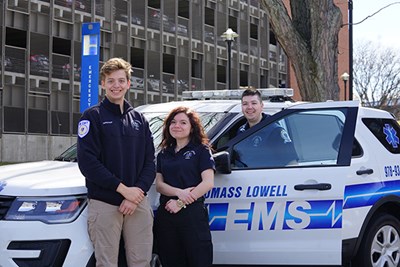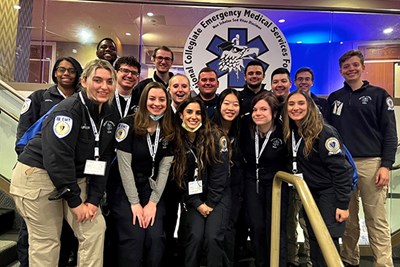UMass Lowell student EMTs take program's pulse at national conference
UML's Emergency Medical Services awarded bronze 'EMS Ready Campus'

Neither rental car snafu nor ice storm could keep 16 students from UMass Lowell’s Emergency Medical Services (EMS) team from traveling to Pittsburgh recently for the National Collegiate EMS Foundation’s annual conference.
More than 800 student EMTs (emergency medical technicians) from over 80 colleges and universities attended the annual three-day conference, where they learned the latest in medical and trauma response, disaster preparedness and emergency management.
Field Supervisor P.J. Roe ’21, a security studies graduate student, organized the trip. He says the conference provided a good gauge of where UML’s EMS program is and where it needs to go.
“It opens your eyes to how far along we are in the program — how our staff has dedicated themselves to providing a high level of care for our campus,” says Roe, a Boston native who earned a bachelor’s degree in criminal justice. “And we’re always looking for improvement, so it’s good to talk with programs that are much further along than we are.”
Around 50 students work as EMTs for UMass Lowell EMS, which is managed by Life Safety and Emergency Management and headquartered on the first floor of Donahue Hall. Students receive small stipends for their work as field supervisors, senior EMTs and cadets, providing supplemental emergency services for university events and offering CPR and first aid training to hundreds of people each year. Once certified, many of the students moonlight as EMTs for local ambulance companies like Trinity EMS, the city’s 911 emergency service provider.
At the conference, UML was recertified as a HeartSafe Campus for its commitment to training and awareness of emergency cardiac care. The university was also recognized once again by the foundation as a bronze-level EMS Ready Campus, a designation for campus EMS agencies that go beyond regular patient care activity and incorporate emergency management education and preparedness activities.
Roe says UML EMS is “pretty close” to a silver designation and hopes to reapply within the year.

Angela Piso, a senior EMT from Franklin, Massachusetts, says she returned home from the conference feeling “motivated to be more involved in the organization.”
A junior biology major, Piso joined EMS as a way to get her foot in the door of the medical field during her first year at UML — just as the COVID-19 pandemic was shutting down the campus. Student EMTs continued providing services for those who remained on campus during the pandemic, and eventually helped the university conduct its surveillance testing program at University Crossing.
“I got to see a lot of different sides of what EMS can be on a college campus,” she says.
As a criminal justice major, Andrew Finerty ’21 says he wasn’t interested in EMS or the medical field. But he kept noticing student EMTs driving their white and blue Ford Explorers around campus and decided to look into the program. When he discovered that he could earn extra points on the civil service exam by becoming an EMT, he signed up.
Now a field supervisor, Finerty is staying on with the program for a post-grad year “to get back the year I missed to COVID.”
Joining Roe, Piso and Finerty in Pittsburgh were: Steve McHugh, Joe Wilson, Brittany Cullen, Ryan Jubb, Amanda Towne, Nancy Wan, Matt Juko, Jazmyne Porter, Matt Cavaco, Jeel Panchal, Helena Hartman, Alex Sousa and Maria Acash.
The group had planned to take two 12-passenger vans to Pittsburgh, but when the rental car company didn’t have them, they had to take four small SUVs instead. Then an ice storm turned what should have been an eight-hour drive into a 14-hour journey.
“It was a travel bonding experience,” Finerty says. “It got a lot of people out of their shells, people we didn’t know much about, and now they’re a big part of the group.”